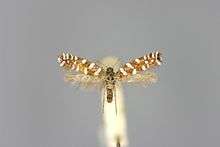Callisto coffeella
Callisto coffeella is a moth of the family Gracillariidae found in Europe. It was first described by Johan Wilhelm Zetterstedt in 1839.
| Callisto coffeella | |
|---|---|
 | |
| Scientific classification | |
| Kingdom: | |
| Phylum: | |
| Class: | |
| Order: | |
| Infraorder: | |
| Family: | |
| Genus: | |
| Species: | C. coffeella |
| Binomial name | |
| Callisto coffeella (Zetterstedt, 1839)[1] | |
| Synonyms | |
| |
Description
The wingspan is 10–12 mm. There is one generation per year, with adults on wing in June.[2]
The larvae feed on mountain willow (Salix arbuscula), tea-leaved willow (Salix phylicifolia), and Salix silesiaca, mining the leaves of their host plant. Young larvae make a distinctly folded lower-surface tentiform mine. After some time, this mine is vacated and the larva lives freely in a leaf margin that has been folded downwards and is secured with silk. In small leaves the two halves are simply spun together in a pod. Two of these leaf folds are made and eaten out.[3]
Distribution
The moth is found from Fennoscandia and northern Russia to the Pyrenees, Italy and Romania and from Scotland to Ukraine.
References
- "Callisto coffeella (Zetterstedt, 1839)". Fauna Europaea. Retrieved 26 December 2019.
- "The Moths of Suffolk". Archived from the original on 2012-03-14. Retrieved 2010-11-04.
- "bladmineerders.nl". Archived from the original on 2012-09-09. Retrieved 2010-11-04.